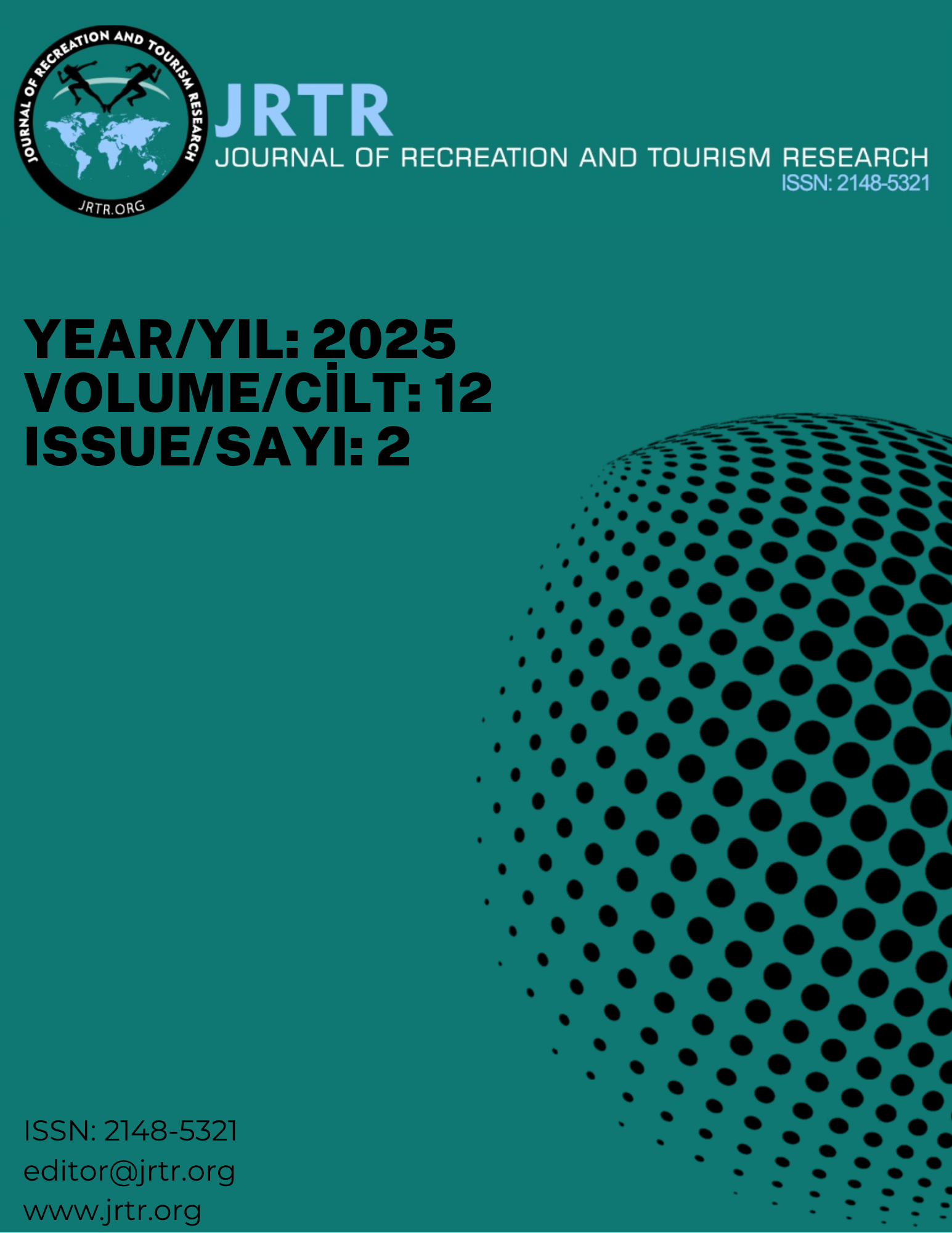Evacuation Times in Natural Disasters: Pathfinder Simulation
DOI:
https://doi.org/10.5281/zenodo.15761463Keywords:
Pathfinder Simulation, Hotel Evacuation Times, Natural Disaster in TourismAbstract
Fires in Turkey cause loss of life and property. When this situation is reflected in the news, it creates a negative image for Turkish tourism. It is not possible to conduct drills while customers are staying in hotels. Existing literature indicates that the Pathfinder program produces results with almost 100% accuracy for the optimization of evacuation processes in public areas (theatres, mosques, etc.). For this reason, the Pathfinder application was preferred in the research. This study was carried out using the Pathfinder application, considering the natural disasters in our country. The aim of the research is to calculate the evacuation processes in disaster situations in hotel architecture plans and to suggest new scenarios. According to the findings obtained, while the evacuation times increase as the number of rooms increases, the extent to which architectural planning increases this evacuation is discussed through figures. For this reason, single, double and triple rooms are drawn randomly, customer evacuation times are evaluated by adding rooms side by side and escape ramps in between, and the current situation is addressed through hotel architecture. As a result, the more hotel rooms there are, the more commercial income is generated, but it has been observed that guest evacuation times are reduced by adding escape ramps by sacrificing rooms. It is thought that this should be taken into consideration in the design of hotel architecture.
Downloads
References
Afet ve Acil Durum Yönetim Başkanlığı, https://www.afad.gov.tr/afad-hakkinda (Erişim 06.05.2025)
BBC, https://www.bbc.com/turkce/articles/clyn3333dp7o (Erişim 01.05.2025)
Euro News, https://tr.euronews.com/2025/01/22/boluda-otel-yangini-faciasinda-olenlerin-sayisi-79a-yukseldi (Erişim 01.05.2025)
Göktaş, L.S. (2023). Kahramanmaraş merkezli depremlerin turizm sektörüne etkisi ve deprem sonrası atılması gerken adımlar hakkında öneriler, Journal of Gastronomy, Hospitality and Travel, 6(2), 624-635
Han, F., Liu, L., & Zhang, Y. (2021). Pathfinder-based simulation and optimisation of personnel evacuation modelling of a shopping mall. In Journal of Physics: Conference Series. 1757 (1), IOP Publishing.
Kadei, S., Sadeghian, S.M.S., Mahidi, M., Asaee, & Mehr,H. (2021). Hotel construction management considering sustainability architecture and environmental ıssues, Hindawi Shock and Vibration, 1, 1-13.
Karadeniz, C.B. (2023). Deprem ve Turizm İlişkisi, Tüm Yönleriyle Depremler ve Etkileri, Berikan Yayınevi, Ankara.
Köşker, H. (2017). Krizlerin turizm sektörüne etkileri üzerine bir araştırma: 2016 yılı türkiye örneği, Akademik Bakış Dergisi, 62, 216-230.
Long, X., Zhang, X., & Lou, B. (2017). Numerical simulation of dormitory building fire and personnel escape based on pyrosim and pathfinder. Journal of the Chinese Institute of Engineers, 40(3), 257-266.
Onursoy, S. (2017). Gazete tasarımında görsel çekim: bir göz takibi çalışması, Anadolu Üniversitesi İletişim Bilimleri Fakültesi Uluslararası Hakemli Dergisi, 25(3), 20-29.
Qin. J., Liu,C. & Huang, Q. (2020). Simulation on fire emergency evacuation in special subway station based on pathfinder, Case Studies in Thermal Engineering, 21, 1-7.
Quan, L. & Ahn, C. (2024). Study on elderly living facilities evacuation based on pathfınder simulation, International Journal of Sustainable Building Technology and Urban Development, 15(7), 247-260.
Rutes, W. A., Penner, R. H., & Adams, L. (2001). Challenges in hotel design: Planning the guest-room floor. The Cornell Hotel and Restaurant Administration Quarterly, 42(4), 77-88.
Selim, A.M., Salama, E.A. & Gaber, H.M (2024). Optimizing safe evacuation using pathfinder: emergency strategies in high-rise and super high-rise complex buildings in the new administrative capital, The Journal of the Housing and Building National Research Center, 20(1), 385-413
Subaşı, M. & Okumuş, K. (2017). Bir araştırma yöntemi olarak durum çalışması, Atatürk Üniversitesi Sosyal Bilimler Enstitüsü Dergisi, 21(4), 419-426
Tofilo, P., Cisek, M., & Lacki, K. (2013). The Study on the Effects of the Counter-Flow on the Evacuation of People from Tall Buildings. In Pedestrian and Evacuation Dynamics 2012, Cham: Springer International Publishing.
Toprakli, A. Y., & Satir, M. S., (2024). Analysis of evacuation times of 15th and 16th century historical mosques in turkey. Journal of The Faculty of Engıneerıng And Archıtecture of Gazı Unıversıty, 39 (3), 1953-1962.
Yiğitoğlu, V. (2023). Doğal afetler ve turizm konulu makalelerin bibliyometrik analizi, Coğrafya, Planlama ve Turizm Stüdyoları, 3(2), 126-139.
Zhang, H., & Long, H.C. (2021). Simulation of Evacuation in Crwoded Places Based on BIM and Pathfinder, Journal of Physics: Conference Series, Conf. Ser. 1880012010
Zhang, H., Miao, Z. H., Lv, H. N., & Leng, Z. L. (2022, June). Evacuation Simulation of Large Theater Based on Pyrosim and Pathfinder. In Journal of Physics: Conference Series, 2289(1) p. 012017. IOP Publishing.
Downloads
Published
How to Cite
Issue
Section
License
Copyright (c) 2025 Journal of Recreation and Tourism Research

This work is licensed under a Creative Commons Attribution-NonCommercial 4.0 International License.






